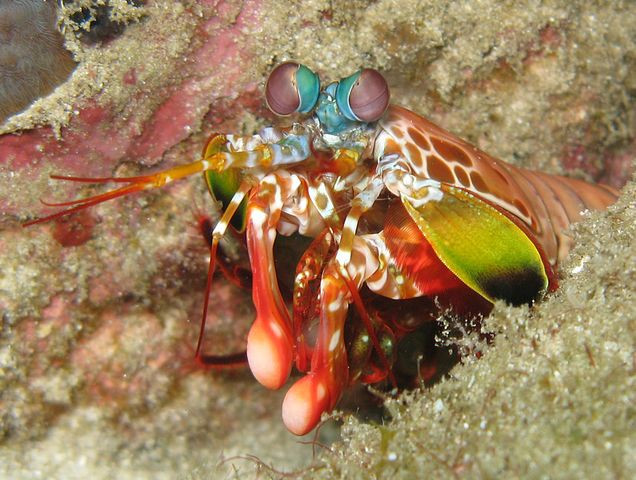Mantis Shrimp Biomimicry: Stomatopod’s Dactyl Club Could Inspire Aerospace Materials, Football Helmets

Science has learned a lot from nature, and studying the finer details of animals to model machinery after them even has a name — biomimicry. The latest example is that of one of the more unusual creatures in nature, the mantis shrimp.
For one, the mantis shrimp is neither a mantis nor a shrimp, though it is distantly related to the latter. Technically, it is a crustacean of the order stomatopoda, and is also called a stomatopod, and it is usually found in shallow waters. It has one of the most advanced and complex eyes and visual system known to humans, but it is better known for a club-like appendage that many of the over 450 species have.
This heavily mineralized appendage, called a dactyl club, is what a new study looked at. The strike of this club (or a spear, stomatopod species feature either one) is among the fastest animal movements known. The appendage moves from standstill to a speed of over 50 miles an hour in an instant. That is so fast that one strike hits the prey twice, once directly and the second time as shockwaves. The impact is hard enough to even break aquarium glass.
The club-wielding mantis shrimps are called smashers, because they smash open hard-shelled prey to get at their food. But the massive impact does no damage to the club itself. And that is what drew scientists to study it for the creation of ultra-strong materials.
A paper Tuesday in the journal Advanced Materials, led by David Kisailus of University of California, Riverside, discussed one of the two interior regions of the dactyl club. Called the striated region, it is made up of a series of fibers that are highly aligned. These fibers wrap around the club the moment it hits its target, so the club itself does not expand from the force of the impact.
“We believe the role of the fiber-reinforced striated region in the smasher’s club is much like the hand wrap used by boxers when they fight: to compress the club and prevent catastrophic cracking. Together, the impact, periodic and striated regions form a club of incredible strength, durability and impact resistance,” Kisailus said in a statement Tuesday.
The spearer species of shrimp mantis are older, in evolutionary terms, and have a similar striated internal region in their spears. This structure may have allowed for the evolution of the dactyl club, the researchers theorized, pointing out that this diversification happened just when hard-shelled prey first appeared.
While stomatopoda are not related to mantis — insects that live over ground, better known as the praying mantis and best known for the female eating the male in many instances during or after mating — a similar striated structure was also found in the tibia of the insects.
The paper also discussed how mantis shrimps attack so rapidly underwater. That is a result of the hydrodynamic teardrop design of the region that comprises of the dactyl club and a neighboring area on the body. This reduces resistance that would be caused by drag, allowing it to shear water at astonishingly fast speeds.
Researchers from Purdue University and Brookhaven National Laboratory were also coauthors on the paper titled “Ecologically Driven Ultrastructural and Hydrodynamic Designs in Stomatopod Cuticles.”
© Copyright IBTimes 2024. All rights reserved.











